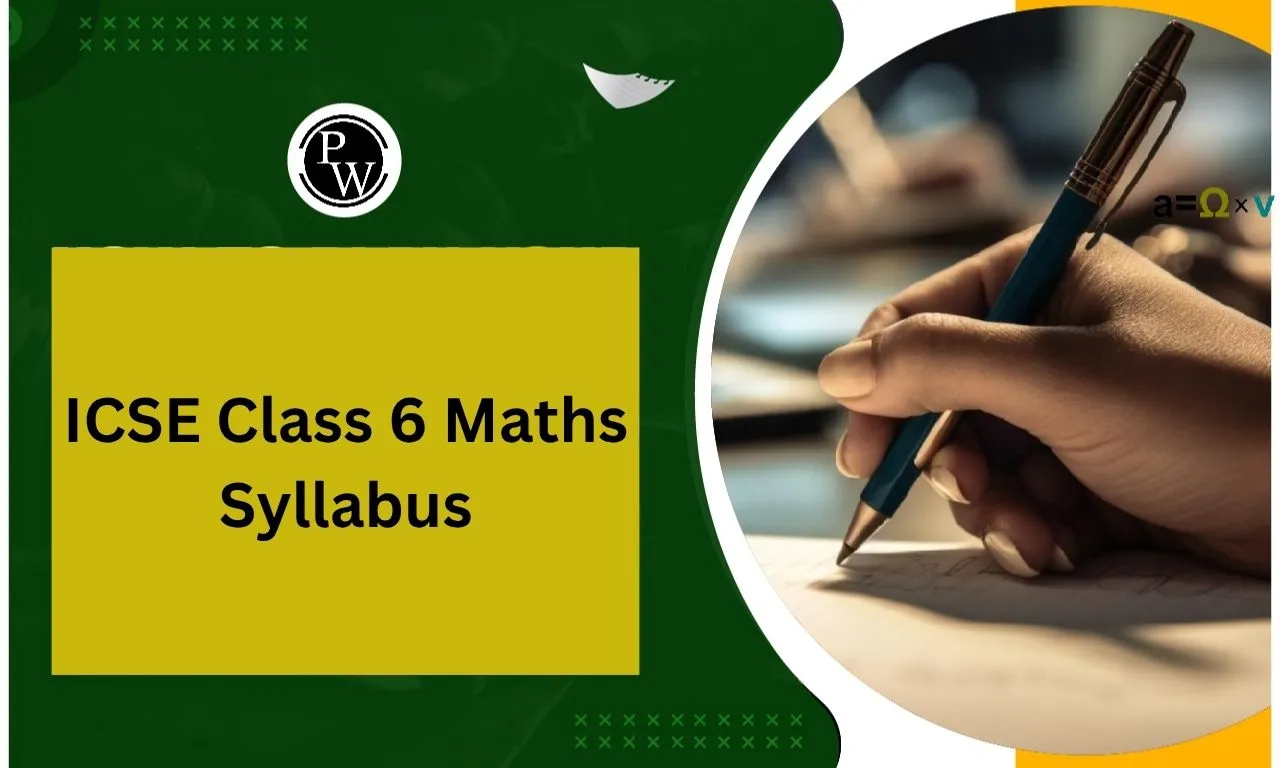The ICSE Class 6 Maths syllabus covers a range of topics like Numbers, Geometry, Algebra, and Mensuration. It is designed to build a strong foundation for advanced mathematical concepts. The exam pattern typically consists of a written paper with a combination of multiple-choice questions, short-answer questions, and long-answer questions.
It evaluates students' understanding and application of mathematical principles. To excel, students should review previous year papers to familiarize themselves with question formats and difficulty levels. Regular practice and understanding core concepts will be key to scoring well in the exam.
ICSE Class 6 Maths Syllabus 2025-26
The ICSE Class 6 Maths syllabus for 2025-26 encompasses a broad range of foundational topics, including Number System, Fractions, Algebraic Expressions, Geometry, and Data Handling. The curriculum is designed to strengthen mathematical concepts and problem-solving skills. Below is the detailed table outlining the chapters included in the syllabus for the academic year 2025-26.
|
ICSE Class 6 Maths Syllabus 2025-26 |
|
|
Chapter Number |
Chapter Name |
|
1 |
Number System |
|
2 |
Numbers in Indian and International System |
|
3 |
Natural Numbers and Whole Numbers |
|
4 |
Negative Numbers and Integers |
|
5 |
Sets |
|
6 |
Fractions |
|
7 |
Decimal Fractions |
|
8 |
Playing with Numbers |
|
9 |
Ratio & Proportion |
|
10 |
Percent |
|
11 |
Idea of Speed, Time and Distance |
|
12 |
Fundamental Concepts |
|
13 |
Framing Algebraic Expressions |
|
14 |
Angles & Their Properties |
|
15 |
Properties of Triangles |
|
16 |
Quadrilaterals |
|
17 |
Circles |
|
18 |
Symmetry |
|
19 |
Constructions |
|
20 |
Recognition of Solids |
|
21 |
Perimeter and Area of Plane Figures |
|
22 |
Data Handling |
Detailed Overview of ICSE Class 6 Maths Syllabus 2025-26
Here's a detailed overview of each chapter in the ICSE Class 6 Maths syllabus for 2025-26:
-
Number System: This chapter introduces the concept of numbers, focusing on their classification and properties. It sets the foundation for understanding various types of numbers used in higher mathematics.
-
Numbers in Indian and International System: Students learn to represent large numbers using both the Indian and International number systems, helping them understand the differences in place value.
-
Natural Numbers and Whole Numbers: This chapter explores natural numbers and whole numbers, emphasizing their properties and the operations that can be performed on them, such as addition and subtraction.
-
Negative Numbers and Integers: The concept of negative numbers and integers is introduced, including operations like addition, subtraction, and understanding their placement on a number line.
-
Sets: Students are introduced to sets, their types, and how they are represented. They will learn about set operations such as union, intersection, and difference.
-
Fractions: This chapter focuses on the understanding of fractions, their types, conversion between fractions, and operations like addition, subtraction, multiplication, and division.
-
Decimal Fractions: Students learn about decimal numbers, their place value, and perform arithmetic operations with decimals, further building their number system knowledge.
-
Playing with Numbers: This chapter explores various interesting properties and patterns in numbers, including divisibility rules, factors, and multiples, along with number puzzles and games.
-
Ratio & Proportion: The concept of ratios and proportions is introduced, where students will learn how to solve real-life problems involving comparisons and relationships between quantities.
-
Percent: Students understand the concept of percentage, its calculation, and real-world applications such as discounts, profit, and loss.
-
Idea of Speed, Time, and Distance: This chapter helps students grasp the basic concepts of speed, time, and distance, along with the formula for calculating each.
-
Fundamental Concepts: This section covers basic mathematical concepts such as factors, multiples, and prime numbers, laying the groundwork for more advanced studies.
-
Framing Algebraic Expressions: Students are introduced to algebraic expressions, understanding how to form and simplify expressions involving variables and constants.
-
Angles & Their Properties: This chapter explains angles, types of angles, and their properties. It also covers the concepts of complementary, supplementary, and adjacent angles.
-
Properties of Triangles: Students explore different types of triangles and their properties, including the angles and sides associated with each triangle.
-
Quadrilaterals: This chapter focuses on quadrilaterals, their properties, and classifications such as squares, rectangles, parallelograms, and rhombuses.
-
Circles: The chapter introduces circles, their parts (center, radius, diameter), and properties, including understanding the circumference and area.
-
Symmetry: Students learn about symmetry, identifying symmetrical shapes, and understanding line symmetry and rotational symmetry.
-
Constructions: This chapter teaches students basic geometric constructions using a compass and ruler, such as bisecting angles and constructing perpendicular lines.
-
Recognition of Solids: Students identify and explore three-dimensional shapes (solids), including spheres, cubes, cones, and cylinders, and learn their properties.
-
Perimeter and Area of Plane Figures: This chapter covers the calculation of the perimeter and area for various two-dimensional shapes like squares, rectangles, and triangles.
-
Data Handling: Students are introduced to the collection, representation, and interpretation of data using bar graphs, pictograms, and tally marks, essential for understanding basic statistics.
ICSE Class 6 Maths Syllabus 2025-26 PDF Download
You can download the ICSE Class 6 Maths Syllabus for the academic year 2025-26 in PDF format. This syllabus includes a detailed breakdown of the topics and chapters that will be covered in the course.
It serves as a comprehensive guide to help students prepare effectively for their exams. Below, we have provided the link to download the PDF for easy access and reference to the complete syllabus.
ICSE Class 6 Maths Syllabus
Study without using the internet
Benefits of Using the ICSE Class 6 Maths Syllabus
Below we have provided the benefits of using the ICSE Class 6 Maths Syllabus -
Clear Structure: The syllabus provides a well-structured outline of topics, making it easier for students to plan their study schedule and stay organized.
Comprehensive Coverage: It covers all essential areas of mathematics such as number systems, algebra, geometry, and data handling, ensuring a balanced approach to learning.
Builds Strong Foundations: Focusing on fundamental concepts helps students develop a strong base, which is essential for more advanced studies in later classes.
Improves Problem-Solving Skills: By providing a mix of theoretical concepts and practical exercises, the syllabus encourages critical thinking and problem-solving, which are vital skills for mathematic
Promotes Conceptual Understanding: The detailed topics and clear explanations allow students to grasp core mathematical concepts, ensuring they understand the "why" behind the methods, not just the "how."
Preparation for Exams: The syllabus serves as a direct guide to exam preparation, covering topics often featured in previous years' question papers, helping students focus on what’s most important.
ICSE Class 6 Maths Syllabus FAQs
What topics are covered in the ICSE Class 6 Maths syllabus?
Is the syllabus updated for 2025-26?
How can I use the syllabus for exam preparation?
Does the syllabus include practical applications?



